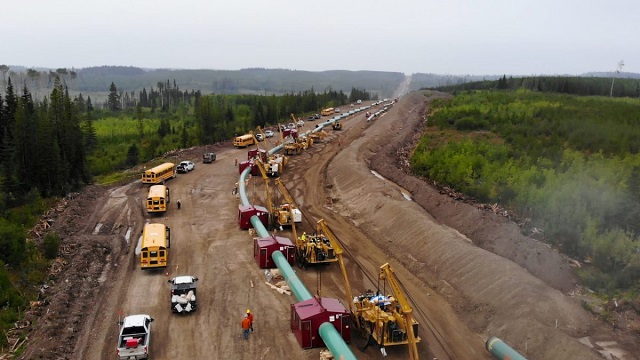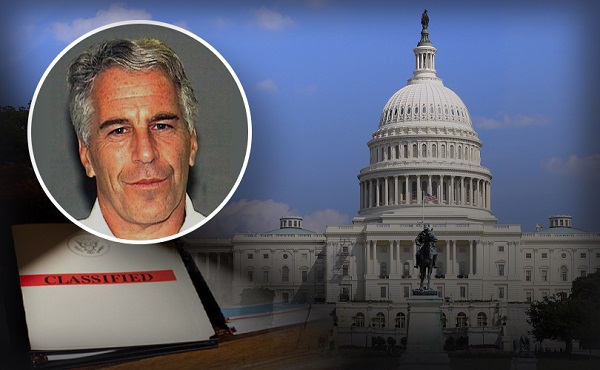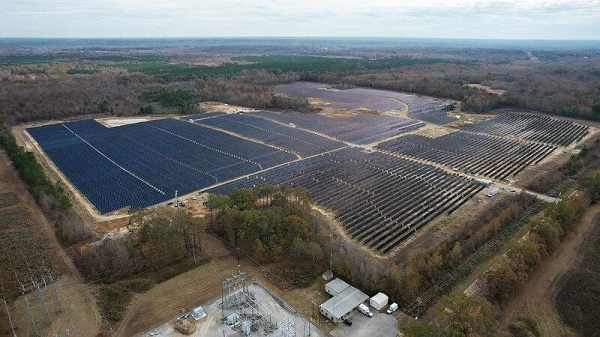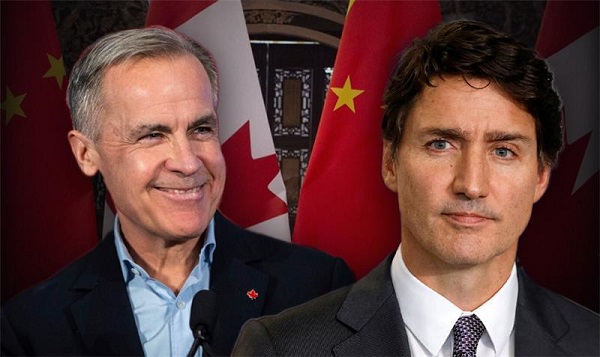Energy
Trump Admin Unveils Massive Oil And Gas Lease Expansion Biden Tried To Squash


From the Daily Caller News Foundation
By Audrey Streb
The Department of the Interior (DOI) released a long-term offshore leasing schedule on Tuesday to boost American energy, standing in contrast with former President Joe Biden’s crackdown on offshore leasing for oil and gas.
In line with the One Big Beautiful Bill Act (OBBBA), the DOI announced a schedule for offshore oil and gas lease sales in the Gulf of America and Alaska’s Cook Inlet, aiming to hold four lease sales by next August and 10 offshore lease sales by 2028, according to the DOI. While the Biden administration clamped down on offshore oil and gas leasing, enacting a last-minute drilling ban across millions of acres and greenlighting a record-low leasing schedule, the Trump administration has moved to reopen federal lands and waters that were locked up.
“The One Big Beautiful Bill Act is a landmark step toward unleashing America’s energy potential,” said Interior Secretary Doug Burgum on Tuesday. “Under President Trump’s leadership, we’re putting in place a bold, long-term program that strengthens American Energy Dominance, creates good-paying jobs and ensures we continue to responsibly develop our offshore resources.”
The first sale under the new law will be titled “Big Beautiful Gulf 1” and is scheduled for Dec. 10, 2025, according to the DOI. The Bureau of Ocean Energy Management (BOEM) will also publish the final notice at least 30 days before the sale, according to the DOI.
The agency noted that the Gulf of America and Alaska’s Cook Inlet both present great potential for expanding American energy and that the lease sales are expected to minimize dependence on foreign imports. About 14.5% of American oil was produced from wells in the Gulf of America in 2022, according to the Energy Information Administration.
Trump signed an executive order to “unleash American energy” and declared a national energy emergency on his first day back in the Oval Office. The OBBBA has also called for more domestic energy opportunities, allowing the DOI to “immediately resume quarterly onshore oil and gas lease sales in compliance with the Mineral Leasing Act” and to hold oil and gas lease sales on available land across several states in the Midwest.
While the Trump administration has focused on boosting conventional energy sources like coal, oil and gas, the Biden administration went all-in with a green energy agenda, approving several massive offshore wind and solar projects. The Biden administration created hurdles for oil and gas both offshore and onshore, leasing a measly amount of acres all while gasoline prices soared. Notably, the Biden administration also froze liquified natural gas (LNG) exports and Biden blocked the major Keystone XL pipeline on his first day as president.
Energy
Will Coastal GasLink Do for Natural Gas What TMX Did For Oil?

From Resource Works
New pipelines already proving their worth
It may have taken a decade, but Canada’s Asia Pacific Gateway now has two new pipelines providing egress for Canadian oil and natural gas to Asia. They are already adding billions to the Canadian economy. TMX alone has added $13 billion to the Alberta economy just in its first year of operation, according to one economist.
One year after Alberta crude started sailing to Asia via an expanded Trans Mountain pipeline and export terminal in Burnaby, Canadian natural gas is also now making its way to Asia, via the Coastal GasLink pipeline and LNG Canada export terminal in Kitimat. On June 30, the first LNG carrier loaded with liquefied Canadian natural gas left Kitimat. To date, half a dozen LNG carriers have loaded up in Kitimat. LNG Canada expects to load one LNG carrier every two days.
In the past, lumber and metallurgical coal have been B.C.’s two most valuable export commodities. By 2026, I wager natural gas will surpass both commodities to become B.C.’s most valuable export. It’s a little too early to tell just what kind of uplift LNG exports will give to B.C. and Alberta’s oil and gas sector, but if TMX is any indicator, it should be substantial. The economics math here is pretty simple. In 2024, half of the natural gas produced in Canada was sold to the U.S. at a price of $2.50 per gigajoule ($2.63 per MMBtu), according to the Canadian Energy Regulator.
The Japan-Korea Marker for LNG prices in Asia, by contrast, is about $15 per MMBtu. So Canadian natural gas sold in Asia is currently worth about six times more than pipeline exports to the U.S. Like Alberta crude oil, Canadian natural gas producers have been selling natural gas at a steep discount to the U.S. For oil, the differential has narrowed, thanks to the Trans Mountain pipeline expansion, according to Charles St-Arnaud, senior economist for Alberta Central. St-Arnaud estimates the price differential between Alberta and American oil has narrowed by about US$8 per barrel, since TMX was commissioned. He estimates this narrower spread has increased revenues by US$9 billion ($13 billion Canadian). “This means that the reduction in the oil discount has boosted oil revenues by about 10 per cent,” St-Arnaud concludes. St-Arnaud estimates this will boost revenues to the Alberta government by $5.3 billion.
The $40 billion question now is whether the Coastal GasLink pipeline and LNG Canada export terminal will provide the same economic uplift for B.C. that TMX has for Alberta. The B.C. government is banking on it. Budget 2025 projects natural gas royalties will double — from $576 million in 2024-25 to $920 million in 2025-26, and $1.2 billion in 2026-27. Heather Exner-Pirot, director of energy, natural resources and environment for the Macdonald-Laurier Institute, notes that even the Globe and Mail‘s editorial board has recently raised flags over B.C.’s massive $208 billion debt and worsening debt-to-GDP ratio. The taxes and royalties from LNG exports will provide important new revenues for B.C. “Your best hope for digging out some of that hole is natural gas exports,” she said.
There is currently such an over-supply of natural gas in Western Canada right now that it may take a while before we start seeing the kind of lift to B.C. gas that TMX gave to Alberta oil. Jackie Forrest, executive director of ARC Energy Research Institute, recently noted that, in 2024, Canadian natural gas sold for “about one-half of the U.S. price — effectively giving it away.” She estimates that, even if Canadian natural gas prices rise just $1 per gigajoule, as a result of new access to tidewater, “producers would gain an additional $7 billion per year.” “And this doesn’t even factor in the additional growth in gas and liquids production that new export terminals can unlock.”
In a recent ARC Energy Research Institute podcast with Mark Fitzgerald, CEO of Petronas Canada — LNG Canada’s second largest shareholder — estimated LNG Canada exports will be worth $2 billion a year to the B.C. economy. “Over the life of the project or the planning cycle that we use, that’s almost ($90 billion) in cumulative government revenue just to the government of British Columbia,” Fitzgerald said. He added: “That development, LNG Canada 1, with the upstream will create more than 100,000 jobs potentially annually across British Columbia.”
That’s just phase 1. The current output of LNG Canada — 14 million tonnes per annum (MTPA) — would double, if the LNG Canada partners sanction a phase 2 expansion. The construction of the Coastal GasLink pipeline facilitated two LNG export projects — LNG Canada and Cedar LNG. But we need another natural gas pipeline to fully exploit our abundant natural gas resources and get full value for them. The next large project in the queue is Ksi Lisims LNG and the associated Prince Rupert Gas Transmission (PRGT) pipeline. This project would add another 12 MPTA of export capacity, not to mention tens of thousands of jobs.
In 2020, the Conference Board of Canada projected Canadian LNG exports could increase Canada’s GDP by $11 billion per year, generate $2 billion a year in additional taxes and royalties, and create 100,000 additional jobs. Had we listened to the critics, who said there would be no market in Asia for Canadian oil and natural gas, and had we not built TMX and CGL, we would still be hostage to a single customer, the U.S., for our oil and gas. We would have foregone tens of billions of dollars in investments, revenue and jobs.
We will certainly hear the same arguments against PRGT and Ksi Lisims that we heard against CGL And LNG Canada. Let’s ignore them this time around, shall we?
Alberta
Change at the top: Rob Morgan is the new CEO of the Alberta Energy Regulator

Rob Morgan, CEO of the Alberta Energy Regulator. Photo courtesy AER
From the Canadian Energy Centre
By Will Gibson
Restructured AER aims a return to its technical roots
Rob Morgan’s introduction to the energy business was a summer job in the Lloydminster region in 1985, when the University of Saskatchewan chemical engineering student got up close and messy with heavy oil production at the wellhead.
“My work boots got very dirty very quickly. That’s the joke about working in heavy oil around Lloydminster. Once it’s on your boots, it never comes off,” says Morgan, a Saskatoon native.
“Working in the field was great because you were hands on with absolutely everything. It was just a fabulous experience.”
Oil stains on his steel-toed boots were not the only thing that stuck with Morgan, who spent the next four decades working in industry before being named CEO of the Alberta Energy Regulator (AER) in February 2025.
Morgan wants to apply some of his hard-earned industry wisdom at the regulator following a 2024 review of the organization by a panel appointed by Premier Danielle Smith.
The panel found a need to return the regulator to its original purpose: resource conservation; orderly but continued economic growth; protection of people, communities, assets and the environment; and regulatory independence.
Returning the regulator to a form closer to its legacy roots will improve Alberta’s reputation as a stable, predictable, internationally competitive and rewarding destination for investment capital, the panel said in its final report.
“The whole world has changed since 2020,” says David Yager, an industry veteran and special advisor to the Premier who chaired the review panel.
New areas of focus including carbon capture and storage (CCS), emerging resources like lithium, and new opportunities like data centres require a modernized approach, Yager says.
“The question was whether or not the regulator was well suited for where the current government wants to take Alberta, and the answer is no, it wasn’t. But that’s changed,” he says.
“The conclusion everybody involved in the review came to is the AER is an independent regulator that needed more direct industry participation, so here we are.”
Prior to taking on the top job at the AER, Morgan retired as CEO of Strathcona Resources, a growing oil and gas producer in Alberta and Saskatchewan.
Along with hiring Morgan, the AER has brought on a reconstituted board of directors as part of implementing the panel’s recommendations.
Chairing the revamped board is Duncan Au, former CEO of CWC Energy Services, a contract drilling and well servicing company operating in Canada and the U.S. that was acquired by Precision Drilling in November 2023.
Just months into their new jobs, Au and Morgan wrote in the AER’s annual report about their new appreciation for the complexity of weighing the various elements of the regulator’s mandate.
“The narrative around energy development has taken on a new sense of urgency not only with a discussion of finding new markets and customers, but also how to grow and diversify Alberta’s role in those markets,” they wrote.
“From oil and gas to emerging opportunities in critical minerals, hydrogen, geothermal, and helium, the AER will be tasked to find the appropriate path among many competing priorities and perspectives.”
Through technological innovation, industry has already reduced environmental impacts, improved worker safety, and boosted economic returns, they wrote.
“It is clear we can continue to modernize our regulations and practices to keep pace with the next wave of technological development and carry out our core regulatory role: translating government legislation into practical regulation that safeguards the environment while ensuring Albertans continue to benefit from the wealth of resources in our province.”
-

 Opinion2 days ago
Opinion2 days agoWhen collective and individual rights clash, media must focus on holding the powerful accountable
-

 International2 days ago
International2 days agoTrump DOJ to share Epstein documents with House Oversight Committee this week
-

 Agriculture2 days ago
Agriculture2 days agoLab-made food won’t win over Canadian shoppers
-

 Energy2 days ago
Energy2 days agoUSDA reverses use of taxpayer dollars to fund solar panels on farmland
-

 Energy2 days ago
Energy2 days agoHow Trump Can End Europe’s Reign Of Terror On American Oil And Gas
-

 Banks1 day ago
Banks1 day agoDebanking is Ottawa’s quiet tool to crush dissent
-

 Agriculture1 day ago
Agriculture1 day agoCanola or cars? Canada can’t save both
-

 Business1 day ago
Business1 day agoForeign Confidence in Canadian Markets Is Collapsing







